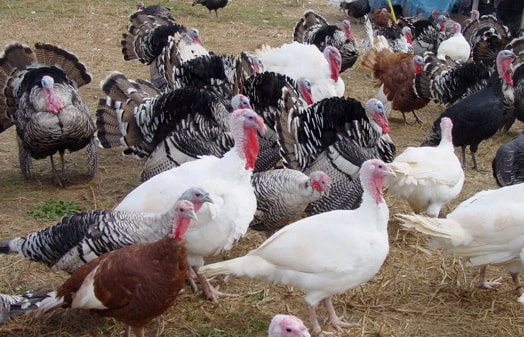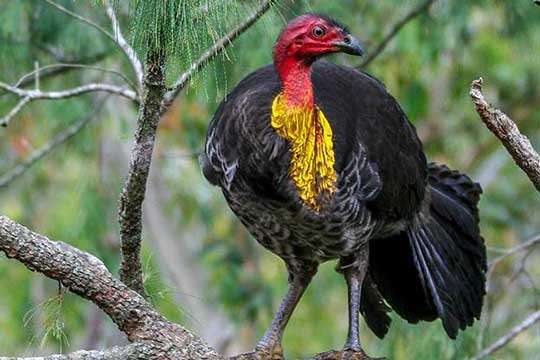|
Meat from domesticated turkeys has become so ubiquitous in grocery stores and restaurants that people tend to forget about the ancestors of the domestic turkey, the wild turkey. But as one of the largest birds in their native range, wild turkeys are fascinating and well worth a closer look. What the heck is a Wild Turkey? Turkeys are large birds that live mostly in North America (US, Mexico, and Canada). Turkeys are in the order Galliformes, which also includes pheasants, chickens, quail, partridges, grouse, junglefowl, and other similar birds). Turkeys are easily recognized by their featherless heads and loose folds of skin on the head and neck. There are only two species of true wild turkeys, and one of the species has five or six distinctive subspecies. The eastern turkey is the subspecies that lives on our new property: Amazing facts about Wild Turkeys Wild turkeys are omnivorous. They not only feed on seeds, nuts, berries, fruits, and grasses, but they also love gobbling (no pun intended) insects, as well as small frogs, salamanders, lizards, and snakes. Turkeys have a lot of names. Mature males are called toms, gobblers, or longbeards. Mature females are hens. Juvenile males are called jakes, whereas juvenile females are jennies. And the chicks are called poults (this word comes from poultry). Male turkeys have elaborate behaviors for attracting and impressing females. They use a gobble call to attract females. Not only is this call quite different from the call of any other bird, it is also loud! A turkey's gobble can be heard a mile away. Perhaps even more impressive than the gobble is the male turkey's ability to strut. They fan out their tail feathers and puff up all their other feathers to look larger. They also emit two other sounds, spitting and drumming, both of which are subtle and rather difficult to capture on video or audio recordings. But if you turn your volume up, you can hear toms spitting and drumming in this video. Below is a tom strutting, trying to impress a hen. To me, she looks only mildly interested. An adult turkey has between 5,000 and 6,000 feathers! Males have sharp, wicked-looking spurs on their legs, which they use when they fight each other for dominance. Males (and 10 to 20% of females) have a long tassel of specialized hair-like feathers hanging from their lower necks, called a beard. Although no one knows for sure, these beards probably help to impress females (the longer the beard, the older and more virile the tom). Turkeys have weird-looking heads. Above the male's beak is a fleshy protuberance called a snood (yep, it really is called a snood). Again, this structure is used to impress females (studies show that females prefer toms with longer snoods... in turkeys, size really does matter). The loose, fleshy stretch of skin below the chin is the wattle. And the bumpy masses of skin on the neck are caruncles. Like a really ugly mood ring, these bumpy parts turn colors depending on the turkey's mood: they turn red to attract a hen, but they turn blue when the turkey is frightened. The tom below has a particularly impressive snood, wattle, and caruncles. Sexy, huh? There is a commonly-believed myth that the wild turkey almost became the national bird of the United States (the bald eagle has that distinction) when Benjamin Franklin argued for it. Here's the true story: Ben Franklin did write a letter to his daughter in 1784, in which he criticized the bald eagle (because it was chosen for the national seal). He wrote that the bald eagle is a bird of bad moral character and does not get his living honestly... he is too lazy to fish for himself. He went on to say that, compared to the eagle, the turkey is a much more respectable bird, and though a little vain and silly, a bird of courage. So, although Ben obviously liked the turkey, technically he didn't really propose making it the national symbol. Wild turkeys were a favorite food of Native Americans. In fact, the turkey is one of only two domesticated birds native to North America (the other is the Muscovy duck). The domestic turkey originally came from Mexico. Native Americans in central Mexico, sometime between 1000 BC and 100 BC, domesticated the south Mexican wild turkey (the only subspecies that does not live in the U.S.). The Spaniards took this domesticated subspecies back to Europe in the 1500s, and eventually it spread throughout Europe as a farm animal. Ironically, settlers from England brought these domestic turkeys with them to Massachusetts, unaware that a larger, closely-related subspecies already lived in the wilds of Massachusetts. It is believed that all domestic turkey breeds came from the south Mexican wild turkey subspecies. Wild turkeys almost went extinct. When Europeans first arrived, millions of turkeys lived from Canada south into Mexico. But by about 1900, most of them were gone due to overhunting and habitat loss. By the late 1930s, there were only 30,000 left. By the 1940s, only isolated pockets of them existed. Through intensive conservation efforts, these birds gradually rebounded. Now it is estimated that about 7 million live in the U.S. Many people are surprised to learn that turkeys can fly. Actually, they are strong flyers (although only for a relatively short distance... about a quarter mile). Turkeys fly up into trees every evening, where they roost in safety for the night. Not only can turkeys fly, but they can run at up to 25 miles per hour (40 kph)! Hen turkeys lay 10 to 14 eggs. The eggs hatch after at least 28 days. The hen feeds the poults, but only briefly. Within a few days, the poults are running around catching insects on their own. The males play no role at all in raising the young. That doesn't seem fair, does it? One last tidbit of information. There are several other birds around the world that are called turkeys, but those are not closely related to the turkeys of North America. One example is the brush turkey of Australia (also called the bush turkey, scrub turkey, or gweela). When Trish and I explored Queensland, Australia last year, we saw many of these. They are not only common, but they often seem unafraid of humans, sometimes walking by within a few meters. These birds are awesome, too, but although they are in the same order, they are in a different family from the wild turkeys of North America. Here's a brush turkey. So, wild turkeys deserve a place in the N.A.H.O.F. (Neato Animal Hall of Fame). FUN FACT: The word neat originated in the early 1300s, and it meant polished, handsome, trim, and clean. At some point the word became a slang expression for great or wonderful. It was already being used a lot when I was a kid in the 1960s, so it must have started before then. And then around 1968, American teens began using a variation of the word: neato. If you say neato today, people would consider you laughably out of touch (or perhaps fashionably retro). Regardless, neato is another way to say awesome! Photo Credits:
Flowing spring and turkeys in yard - Stan C. Smith Bearded Tom Turkey - National Wild Turkey Federation Tom strutting for hen - Robert Burton/USFWS Tom snood and wattle - Lansing Wild Birds Unlimited Domestic turkeys - All Over Albany Hen turkey with poults - TribLive via Wikimedia Commons Australian brush turkey - Di Donovan via ABC
0 Comments
Leave a Reply. |
Stan's Cogitations
Everyone needs a creative outlet. That's why I write. Archives
July 2024
|






 RSS Feed
RSS Feed